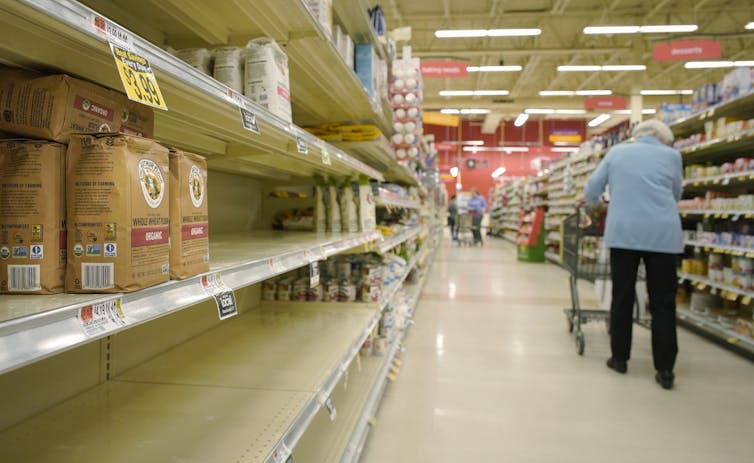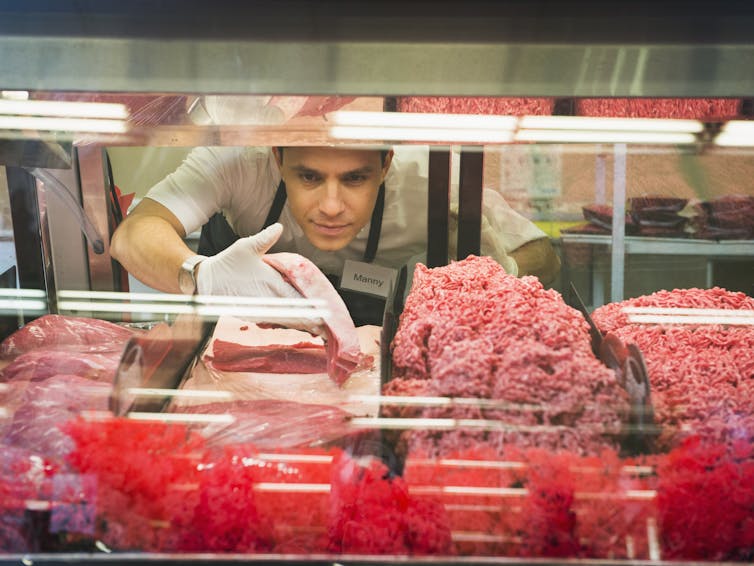
Flour has been in short supply in recent weeks. Gregory Rec/Portland Press Herald via Getty Images
By Nada R. Sanders, The Conversation | April 9, 2020
Retailers are frequently running out of everything from flour and fresh meat to toilet paper and pharmaceuticals as supply chains hammered by the coronavirus struggle to keep up with stockpiling consumers.
Although out-of-stock products are usually replenished within a day or two, the sight of bare shelves typically prompts more hoarding as people fear the supply of the goods they need may be cut off. This vicious cycle is a direct result of shortcomings of modern supply chains, which most companies, regardless of industry, now use.
As an expert on supply chain management, I believe three main characteristics of today’s supply chain are largely to blame.

Toilet paper has seen persistent supply shortages. Michael Siluk/Education Images/Universal Images Group via Getty Images
1. Supply chains have become very complex
Fundamentally, a supply chain links a series of companies that make, transport, refine and deliver the finished product you buy at a retailer, restaurant or anywhere else.
Consider a cup of coffee from Starbucks. Your coffee might begin as a pile of coffee beans grown and picked by a farmer in Guatemala. They’re then shipped to a coffee roaster, say in Seattle, who then sends them on to a distributor near where you live, who sells them to your local Starbucks.
A shutdown anywhere along the supply chain in any of these locations stops this flow and could prevent you from enjoying your morning brew.
While a coffee supply chain may be relatively simple and linear, it can quickly get complicated for products that have many parts, such as an Apple iPhone. Apple actually has suppliers in 43 countries, and tracing the journey of any one component is difficult. For example, one of the chips that run an iPhone is designed in California but made in Taiwan, tested in the Philippines and then added to Apple products in China.
And many companies often share the same supplier, such as Intel for processors or Kimberly Clark for the fiber in toilet paper. So a hiccup in one link in the supply chain can have ripple effects across companies around the world.
The result is that the vast majority of global companies don’t fully grasp their risk exposure. Few, if any, have complete knowledge of the locations of all the companies that provide parts to their direct suppliers. Even supply chains for foods like bananas are long and complex, as most produce comes from countries across the globe.
Compounding the complexity is the problem of capacity, which is how much of something each company in a supply chain can produce. Rapidly increasing capacity is hard. Just think about the difference in hosting a dinner party for two guests versus 200. That is exactly why there is a shortage of hand sanitizer. Customers are buying huge amounts, but suppliers are not able to increase available amounts of essential ingredients, such as alcohol, glycerol and hydrogen peroxide.
2. A lean machine
What has made these supply chains even more vulnerable are strategies that rely heavily on “just in time” or lean inventory replenishment. That is, companies maintain only enough stock on hand for a short duration and rely on small deliveries made frequently to keeps costs low.
For example, many companies keep just enough inventory to last a few weeks, confident that products will arrive as they are needed. That system works perfectly well provided there are no disruptions.
However, as companies in a wide variety of industries, including food, retail, high-tech and automotive, have increasingly implemented this strategy, they no longer have the extra inventory or excess capacity to make up for production losses caused by a disruption. As a result, these businesses are highly vulnerable to even a short material-flow problem. When an earthquake shook Taiwan on Sept. 21, 1999, it created a huge disruption for the computer-chip industry, delaying shipping times for some products by more than a week.
Similarly, since lean systems removed most excess inventory, many medical supply chains were not able to respond to disruptions during emergence of the avian influenza, or “bird flu,” in 2005.
Yet those were relatively minor, regional disruptions. The coronavirus pandemic has virtually shut down dozens of economies, with movements of over a third of the global population restricted. This means a surge in demand for any product could easily result in shortages for days or weeks.
Having a lean inventory is a strategy with many benefits and is designed to eliminate waste and cut costs. However, many companies may have taken it too far. In an era of global connectivity, a disruption anywhere can trickle down the entire supply chain.

Ground beef is a prime example of a lean supply chain. Erik Isakson/Getty Images
3. Moving manufacturing offshore
Further exacerbating the problem is the strategy of offshoring, in which companies manufacture their products overseas in countries like China, Vietnam and Malaysia in an effort to cut costs.
On the plus side, this has allowed many companies to reduce the number of links in their supply chains – or at least shrink the distance between them – by relying primarily on a smaller number of sources that are concentrated in a specific geographic area.
But in this quest to lower operating costs, including labor and overhead, more companies have put too many of their “eggs” in one basket. Certain industries have favored certain regions, with the auto, tech and agricultural industries favoring China. India, on the other hand, has become the primary source for generic drugs.
As a result, disruptions in a single country become even more severe. In January, well before the U.S. and countries in Europe had coronavirus outbreaks of their own, Western companies and retailers were already bracing for severe supply chain problems after China’s economy went into lockdown. And the impacts are still being felt several months later on all kinds of products, from toys and TV screens to sponges and ink cartridges, and could even extend into Christmas.
Getting ready for the next crisis
Of course, it makes sense that companies would do all they can to reduce costs and make their supply chains as efficient as possible.
That has made them incredibly vulnerable to disruptions, even minor ones. And the coronavirus pandemic is a disruption like no other, and undoubtedly people will continue to see temporary and longer shortages of essential goods as long as it lasts. My biggest concern is that if COVID-19 continues to spread throughout the U.S., devastating the ranks of large meat packing plants and other factories and farms, Americans will begin to experience severe scarcity of foods and other goods.
While it’s probably too late to do much about the current crisis, I hope companies learn these lessons and adopt better strategies to manage their supply chains risks, such as by putting in place more backup suppliers and building up more inventory.
Maybe then more of them will be ready for the next disruption.
[Get facts about coronavirus and the latest research. Sign up for The Conversation’s newsletter.]Nada R. Sanders, Distinguished Professor of Supply Chain Management, Northeastern University
This article is republished from The Conversation under a Creative Commons license. Read the original article.
